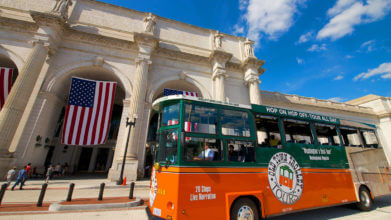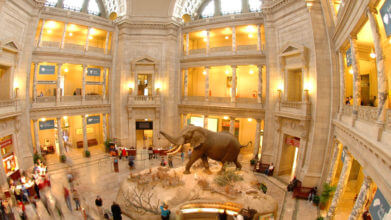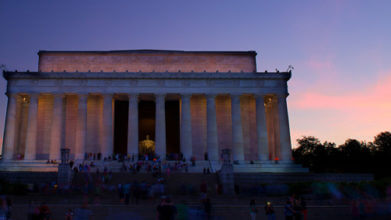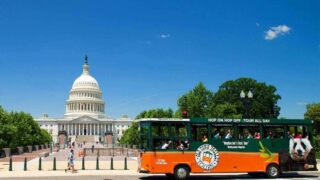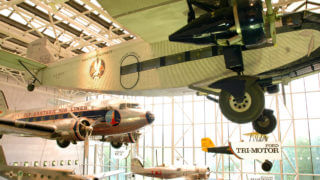Ford’s Theatre
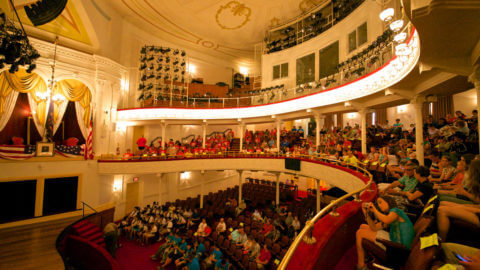
The chilling story of Abraham Lincoln’s assassination comes to life in the very place he was mortally shot on April 14, 1865. After being closed for 103 years, Ford’s Theater was restored and reopened in 1968. Serving as a tribute to Abraham Lincoln and his love of the performing arts, the Theater is a live, working theater that plays host to a variety of plays by some of the country’s most talented playwrights, actors and artists. Ford’s Theater is also home to The Lincoln Museum, which gives visitors a look at the elaborate conspiracy planned by actor John Wilkes Booth, a supporter of the Confederate States of America, to assassinate the President, the Vice President and the Secretary of State.
A Visitor’s Guide to Ford’s Theatre
The story of Abraham Lincoln’s assassination is best experienced at Ford’s Theatre, where he was mortally shot on April 14, 1865. After being closed for 103 years, Ford’s Theatre was restored and reopened in 1968. Serving as a tribute to Abraham Lincoln and his love of the performing arts, the theater is a working venue that hosts various plays by some of the country’s most talented playwrights, actors, and artists. Ford’s Theatre is also home to The Lincoln Museum, which offers visitors a deep dive into the elaborate conspiracy orchestrated by actor John Wilkes Booth, a supporter of the Confederate States of America, to assassinate the president, the vice president and the secretary of state. The museum presents invaluable context on the events surrounding the Lincoln assassination.
Visiting Ford’s Theater with Old Town Trolley Tours
The definitive way to visit Ford’s Theatre National Historic Site, the location of President Abraham Lincoln’s assassination, is with Old Town Trolley Tours. This comprehensive, narrated hop-on, hop-off service delivers you directly to the historic landmark, providing the essential context needed to fully appreciate this pivotal moment in American history. The Old Town Trolley Tours route ensures effortless, convenient access to one of Washington D.C.’s most profound historical attractions
Why Choose Old Town Trolley Tours
- Direct Trolley Stop: Ford’s Theatre is a dedicated and convenient stop (Stop 13) on the full D.C. tour loop.
- Expert Narrated History: Receive a 100% live historical narration detailing Lincoln’s final days and the events of April 14, 1865, as you approach the site.
- Seamless D.C. Sightseeing: Connect this downtown historical site easily with the White House, the National Mall, and other major monuments on a single route.
- Skip the Hassle:Avoid D.C. traffic, costly parking, and the logistics of navigating public transportation.
Experience the Ford’s Theatre Complex
The Old Town Trolley Tours stop allows you to explore the entire National Historic Site complex, which memorializes the tragedy and celebrates Lincoln’s life.
- Tickets Are Required: Entry to the complex requires a ticket. Purchasing in advance is highly advisable, especially during peak seasons, to ensure you secure your preferred time.
- Witness the Scene of Tragedy: Step into the theater to view the Presidential Box where Abraham Lincoln was mortally wounded by John Wilkes Booth on April 14, 1865.
- Explore the Lincoln Museum: Located on the lower level, this museum offers invaluable context on the assassination. Artifacts and exhibits bring the era to life and detail the elaborate conspiracy planned by Booth.
- Visit the Petersen House: Just across the street lies the historic home where President Lincoln was carried after the shooting. A tour here provides a poignant conclusion to the story, allowing you to stand in the room where the President passed away.
- Enjoy Convenient Trolley Access: Ford’s Theatre is a designated Old Town Trolley stop. You can easily hop off to explore the complex and hop back on to connect directly to the National Mall, White House, and other major landmarks.
History of Ford’s Theatre
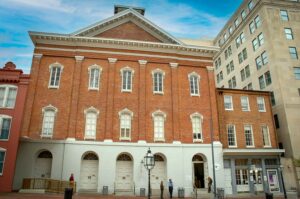 The building that became Ford’s Theatre National Historic Site originally served as the First Baptist Church of Washington. In 1861, John T. Ford rented the structure and reimagined it as a theater, initially named Ford’s Athenaeum. However, after a destructive fire in 1862, Ford purchased the building and invested in its redesign and expansion. It reopened in 1863 as Ford’s New Theatre. Ford’s Theatre is best known for being the site of Abraham Lincoln’s assassination. On April 14, 1865, John Wilkes Booth entered the theater box where Lincoln was watching a performance of Our American Cousin. Booth slipped a derringer pistol from his pocket and fatally shot Lincoln in the head. This tragic moment remains one of the most infamous acts in American history, making Ford’s Theatre synonymous with the Lincoln assassination.
The building that became Ford’s Theatre National Historic Site originally served as the First Baptist Church of Washington. In 1861, John T. Ford rented the structure and reimagined it as a theater, initially named Ford’s Athenaeum. However, after a destructive fire in 1862, Ford purchased the building and invested in its redesign and expansion. It reopened in 1863 as Ford’s New Theatre. Ford’s Theatre is best known for being the site of Abraham Lincoln’s assassination. On April 14, 1865, John Wilkes Booth entered the theater box where Lincoln was watching a performance of Our American Cousin. Booth slipped a derringer pistol from his pocket and fatally shot Lincoln in the head. This tragic moment remains one of the most infamous acts in American history, making Ford’s Theatre synonymous with the Lincoln assassination.
After the shooting, the mortally wounded Lincoln was carried across the street to the Petersen House, where he passed away the next morning. The War Department later took control of Ford’s Theatre, repurposing it into a three-story office building. In 1893, part of the interior flooring collapsed, resulting in 22 fatalities and prompting significant repairs. The building eventually transitioned into a museum in 1932, marking a shift in its use from government offices to a historical site.
In 1965, restoration efforts began to return Ford’s Theatre to its 1865 appearance, reflecting the time of the Lincoln assassination. The Lincoln Museum was relocated to the basement of the theater, enriching the site’s historical narrative. The National Park Service, in partnership with Ford’s Theatre Society, continued modernization efforts to preserve this vital connection to the events of the Lincoln assassination and Abraham Lincoln’s legacy.
Interesting Facts About Ford’s Theatre
Ford’s Theatre has a fascinating history that extends beyond the tragic events of April 14, 1865.
- After Lincoln’s assassination, Ford’s Theatre remained closed for five years before reopening as a performance venue.
- It was officially designated as a National Historic Site in 1932, preserving its legacy as the place where a pivotal moment in American history occurred.
- Interestingly, Washington’s YMCA once considered purchasing the structure and renaming it “The Abraham Lincoln Memorial Temple” but ultimately decided against the idea.
Today, Ford’s Theatre National Historic Site interprets the events surrounding the Lincoln assassination and continues to honor Lincoln’s legacy. The site remains a central part of Washington, DC, welcoming approximately 650,000 visitors annually.
Know Before You Go
Location: Ford’s Theatre is conveniently situated in Downtown Washington, DC, close to other major historical landmarks like the National Mall, the White House, and the Capitol Building. Its central location makes it easily accessible for those visiting nearby attractions, offering a perfect starting point for exploring the rich history of the nation’s capital.
Tickets and Reservations: It’s advisable to purchase tickets in advance, especially during peak tourist seasons like spring and summer. With high visitor interest and limited capacity, availability can be limited, and booking ahead ensures you secure your preferred time for performances, tours or museum visits. Advanced reservations are particularly recommended for guided tours, which often fill up quickly and provide deeper insights into the events surrounding the Lincoln assassination.
Visiting Hours: Ford’s Theatre typically operates with varying hours throughout the year, so it’s best to check their official website for up-to-date visiting hours, holiday closures and special events.
Timing Your Visit: To fully appreciate the exhibits and experience a performance, plan to spend at least one to two hours at Ford’s Theatre. This time frame allows you to explore the museum exhibits, take a guided tour, and, if available, attend a theatrical production that highlights the venue’s historical ambiance. For those with a deeper interest in Lincoln’s legacy, an extended visit may be worthwhile.
Transportation: Ford’s Theatre is easily accessible via various public transportation options, including Metrobus and Metrorail services. It’s also a convenient stop on Old Town Trolley Tours®, which offers a hop-on, hop-off experience that includes commentary on DC’s rich history and landmarks, including Ford’s Theatre. The trolley tour provides an ideal option for those who want to explore the city at their own pace, making it easy to visit multiple attractions in one day.
Security Procedures: As a National Historic Site, Ford’s Theatre has security measures in place to ensure the safety of all visitors. Be prepared for bag checks and metal detectors upon entry to maintain the safety and security of all guests. It’s best to carry only essential items to speed up the security process and ensure a smooth entry experience.
Accessibility: The theater is equipped to accommodate visitors with disabilities, offering features such as ramps and elevators for easy access. If you require specific assistance or have mobility concerns, it’s a good idea to contact the venue in advance to ensure your needs are met. The friendly staff is always ready to assist and make your visit as comfortable as possible.
Things To Do at Ford’s Theatre
Watch a Live Performance
Attending a live performance at Ford’s Theatre is a unique opportunity to connect with the history of this iconic venue. The theater is known for its exceptional productions, ranging from classic plays to contemporary works, all presented in a space that resonates deeply with American history and Abraham Lincoln’s legacy. Watching a show here offers a rare chance to experience live theater in a truly historic setting while reflecting on the events surrounding the Lincoln assassination.
Visit the Ford’s Theatre Museum
The Ford’s Theatre Museum provides a comprehensive look at the events leading up to the Lincoln assassination. It features exhibits on John Wilkes Booth, Abraham Lincoln’s presidency, and the broader historical context of the Civil War, offering a deeply engaging experience for history enthusiasts and those new to the subject alike. Artifacts, photographs, and interactive displays bring the era vividly to life, allowing visitors to connect with the period in an immersive and meaningful way. It’s not only a museum but also a space for reflection on how Lincoln’s leadership shaped the nation.
Take a Guided Tour
A guided tour of Ford’s Theatre offers insights into the building’s architecture, its role in the Lincoln assassination, and its evolution over time. Knowledgeable guides bring the history to life, making the tour a memorable part of any visit. These tours often include behind-the-scenes stories and details that are not covered in the exhibits, providing a richer experience for visitors while emphasizing the significance of Abraham Lincoln’s contributions to American history. The tours also often highlight architectural elements of the building, offering an appreciation for its 19th-century design while connecting these features to the fateful events of 1865. Whether you’re a seasoned history buff or a curious traveler, the guided tours provide context and depth to your visit.
Attend Special Events
Throughout the year, Ford’s Theatre hosts special events, including seasonal performances, lectures, and workshops. These events provide unique opportunities to engage with American history and the performing arts in an iconic setting. Special commemorations, such as the anniversary of the Lincoln assassination, offer a deeper understanding of the theater’s historical importance and its enduring connection to Abraham Lincoln’s legacy. Visitors can also participate in interactive events, like panel discussions with historians or reenactments, which add another layer of engagement. These programs ensure that Ford’s Theatre remains not only a place of remembrance but also a living, active part of the community.
Explore the Petersen House
Just across the street from Ford’s Theatre, the Petersen House is where Abraham Lincoln was taken after being shot. Visitors can explore this historic home and learn about the final hours of Lincoln’s life, adding depth to their understanding of this tragic moment. The house remains a poignant reminder of the nation’s sorrow during those difficult hours, directly tied to the events of the Lincoln assassination. Exhibits in the Petersen House focus on the immediate aftermath of Lincoln’s death and its impact on the nation. Standing in the same rooms where these events unfolded offers visitors a profoundly emotional connection to history, making the Petersen House an essential complement to any visit to Ford’s Theatre.
Enjoy the Gift Shop
Before leaving, be sure to visit the theater’s gift shop. It offers a variety of unique souvenirs, books, and memorabilia related to American history, Abraham Lincoln’s legacy and the story of Ford’s Theatre. You can find keepsakes that commemorate your visit and learn more about Lincoln through the carefully curated selection of literature. In addition to books and artifacts, the shop features replicas of historical items and modern interpretations inspired by the Civil War era. It’s an ideal stop for anyone looking to take a piece of history home or deepen their knowledge of Lincoln’s presidency and its impact.
Engage in Educational Programs
Ford’s Theatre offers educational programs designed for students, educators, and history enthusiasts. These programs explore the Lincoln assassination, the impact of the Civil War, and the enduring significance of Abraham Lincoln’s leadership. They provide a great way for families and school groups to deepen their understanding of this pivotal moment in American history. From workshops that analyze historical documents to creative projects centered on Lincoln’s speeches, the programs engage participants of all ages. These offerings ensure that visitors leave with a greater appreciation of both the man and the monumental legacy he left behind.
Nearby Things To Do
Petersen Boarding House
This historic house, where Abraham Lincoln breathed his last, is a sobering site that complements a visit to Ford’s Theatre, offering further context to the tragic events of April 14, 1865. Guided tours provide insight into the final hours of Lincoln’s life and the nation’s response to his passing, connecting visitors to the story of the Lincoln assassination.
Washington Welcome Center
Just a short distance from Ford’s Theatre, the Washington Welcome Center offers helpful information and resources for tourists exploring the capital. It’s a great place to gather maps, plan your itinerary and learn about other must-see destinations around Washington, DC, while tying it back to your exploration of Abraham Lincoln’s story.
National Portrait Gallery
Located nearby, the National Portrait Gallery showcases portraits of America’s leaders, including an extensive collection dedicated to Abraham Lincoln. It’s a perfect addition to a day of historical exploration, allowing visitors to see how Lincoln’s image has been remembered and celebrated through art and how the Lincoln assassination shaped his legacy.
FAQs
Why is Ford’s Theatre so famous?
Ford’s Theatre is renowned as the site of Abraham Lincoln’s assassination, a pivotal event in American history that occurred on April 14, 1865. The tragic incident profoundly impacted the nation, marking the end of the Civil War era and the beginning of Reconstruction. The theater now serves as a place of remembrance and education, offering insights into Lincoln’s life and the events leading up to the Lincoln assassination.
Who was shot in Ford’s Theatre?
President Abraham Lincoln was shot in Ford’s Theatre by John Wilkes Booth, a Confederate sympathizer, on the evening of April 14, 1865. Lincoln was attending a performance of Our American Cousin when Booth entered his box and fired a single shot. The president was taken to the Petersen House across the street, where he succumbed to his injuries the following morning, forever linking the theater to the Lincoln assassination.
Is Ford’s Theatre suitable for children?
Yes, Ford’s Theatre is suitable for children, especially those interested in American history. The museum exhibits are designed to be engaging for all ages, providing a balanced narrative of the events surrounding Abraham Lincoln’s presidency and assassination. Educational programs and guided tours offer enriching experiences that help young visitors understand the historical importance of the Lincoln assassination and Lincoln’s enduring legacy.

